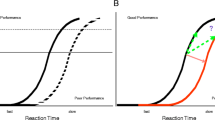Abstract
We investigated the effect of different spatial and temporal parameters on the saccadic reaction times (SRTs) of the antisaccades and on the frequency and the SRTs of erratic prosaccades in five adult human subjects. The subjects were instructed to aim their saccades to the side opposite to where a visual go-stimulus occurred. Parameters under consideration were: the gap duration (between 0 and 600 ms, and an overlap paradigm); the stimulus size (sizes of 0.1°, 0.2°, and 0.4°, using the gap 200-ms paradigm); and the stimulus eccentricity (1°, 2°,4°, 8°, and 12°, with the gap 200-ms paradigm). A decrease in the anti SRTs and an increase in the error rate were observed with medium gap durations (200 ms, 250 ms), while the anti-SRTs were longer and the error rates lower with the shorter values (0 ms, 100 ms, and with the overlap paradigm) and with the long values (600 ms). A slight decrease in the anti-SRTs and an increase in the error frequency occurred with increasing eccentricity; the SRT distributions of the errors resembled closely those of prosaccades in corresponding prosaccade tasks with the same eccentricities. The stimulus size had only modest or no effects at all. Analysis of the distributions of the correction times of the erratic prosaccades showed that the intersaccadic intervals could be very short: in the range of express saccades, with a peak at 100 ms; or in some subjects even shorter, with a peak at 40–50 ms. It is concluded that the performance of antisaccades is influenced by parameters that interact with the fixation and/or attention system of oculomotor control. Parameters supporting a disengagement of fixation at the time of stimulus onset provoke a reduction of the saccadic reaction times not only of prosaccades but also of antisaccades. Moreover, a certain state of disengagement seems to facilitate the occurrence of reflex-like errors.
Similar content being viewed by others
Author information
Authors and Affiliations
Additional information
Received: 3 July 1996 / Accepted: 29 March 1997
Rights and permissions
About this article
Cite this article
Fischer, B., Weber, H. Effects of stimulus conditions on the performance of antisaccades in man. Exp Brain Res 116, 191–200 (1997). https://doi.org/10.1007/PL00005749
Issue Date:
DOI: https://doi.org/10.1007/PL00005749




